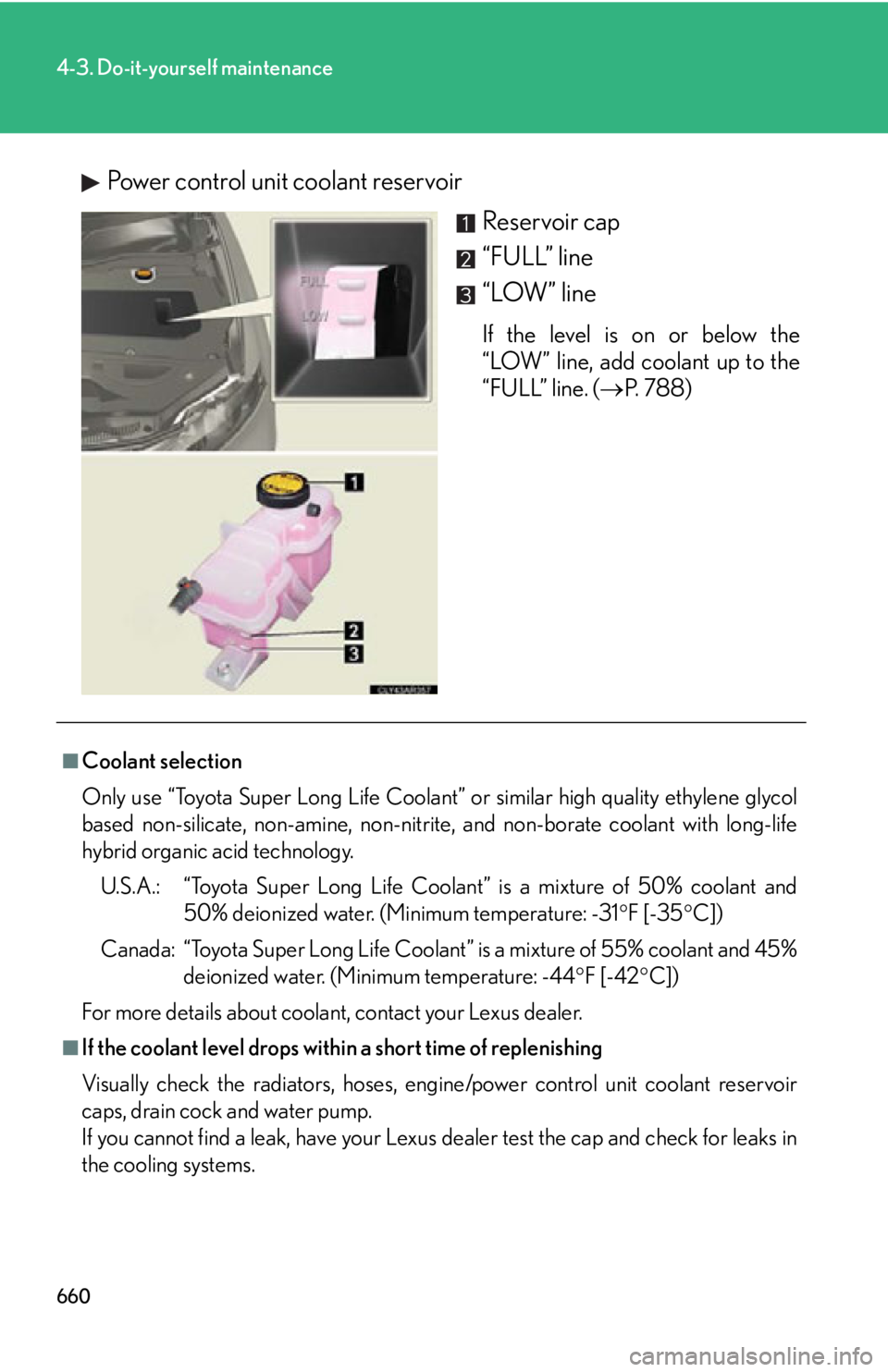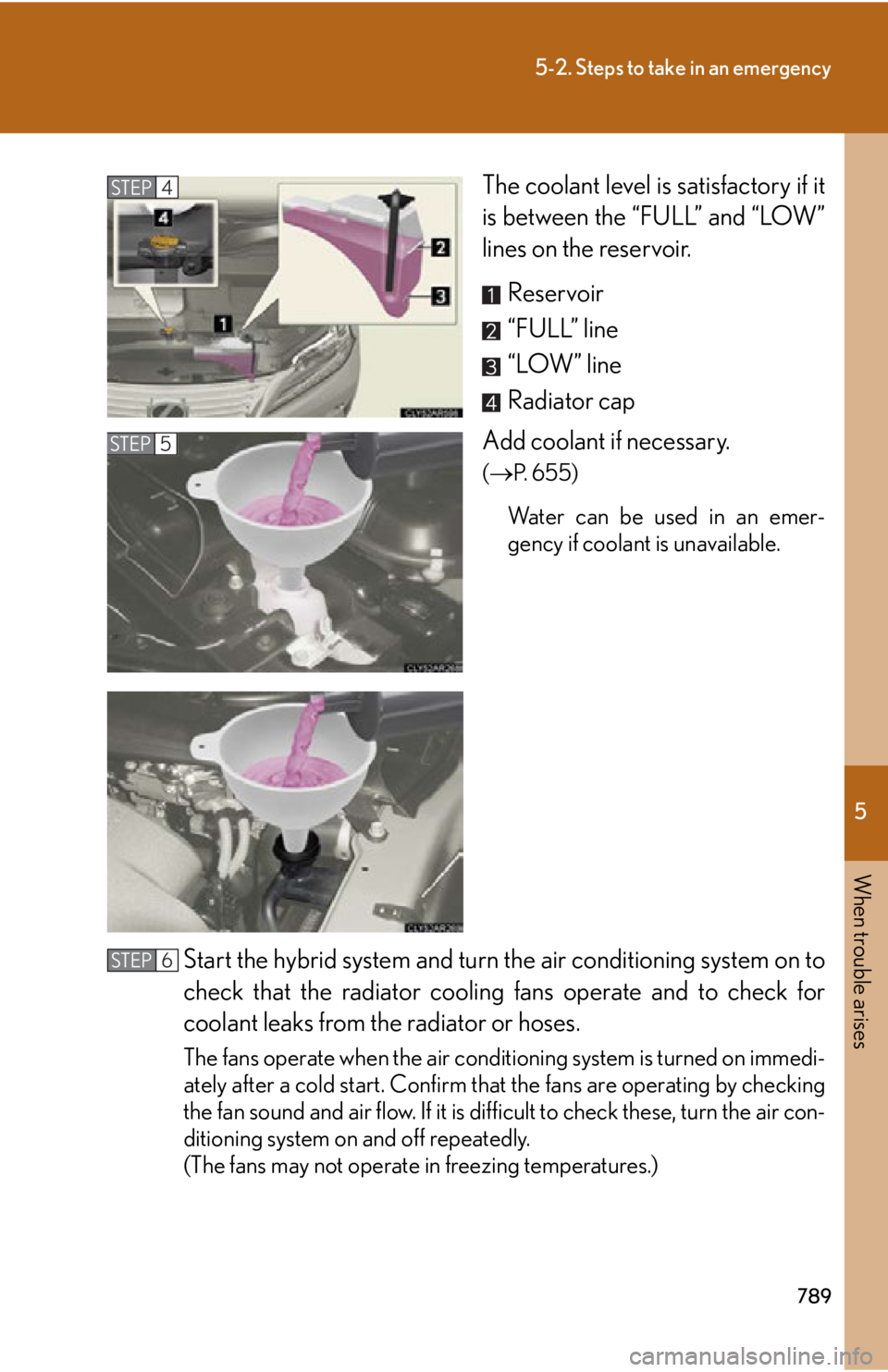2015 LEXUS RX450h coolant temperature
[x] Cancel search: coolant temperaturePage 184 of 878

1842-1. Driving procedures
■
Situations in which EV driv e mode cannot be turned on
It may not be possible to turn EV drive mode on in the following situations. If it can-
not be turned on, a buzzer will sound and a message will be shown on the multi-
information display. ●
The temperature of the hybrid system is high.
The vehicle has been left in the sun, driv en on a hill, driven at high speeds, etc.●
The temperature of the hybrid system is low.
The vehicle has been left in extremely low temperatures for a long period of
time etc.●
The gasoline engine is warming up.●
The hybrid battery (traction battery) is low.●
Vehicle speed is about 25 mph (40 km/h) or more.●
The accelerator pedal is depressed firmly or the vehicle is on a hill etc.●
The windshield defogger is in use.■
Automatic cancelation of EV drive mode
When driving in EV drive mode, the gasoline engine may automatically restart in
the following situations. When EV drive mo de is canceled, a buzzer will sound and
the EV drive mode indicator will flash and go off. ●
The hybrid battery (traction battery) becomes low.●
Vehicle speed becomes more than about 25 mph (40 km/h).
If engine coolant temperature is low, EV drive mode may be canceled when
vehicle speed is below 25 mph (40 km/h).●
The accelerator pedal is depressed firmly or the vehicle is on a hill etc.
When it is possible to inform the driver of automatic cancelation in advance, a prior
notice screen will appear on the multi-information display.■
Possible driving distance when driving in EV drive mode
In EV drive mode, it is possible to drive up about 1 /2 mile (1 km) if driving at a speed
of about 25 mph (40 km/h) or less.
(The distance that is possible depends on the hybrid battery [traction battery] level
and driving conditions.)
■
Fuel economy
RX450h is designed to achieve the best po ssible fuel economy during normal driv-
ing (using the gasoline engine and electric motor [traction motor]). Driving in EV
drive mode more than necessary may lower fuel economy.
Page 197 of 878

1972
When driving 2-2. Instrument cluster
Gauges and meters
Hybrid System Indicator Displays hybrid system power output and regenerative charging level
ECO lamp and SPORT lamp Changes colors according to driving mode
Speedometer Displays the vehicle speed
Fuel gauge Displays the quantity of fuel remaining in the tank
Multi-information display Presents the driver with a variety of driving-related data ( P. 2 0 6 )
Odometer and trip meter
Odometer: Displays the total distance the vehicle has been driven
Trip meter: Displays the distance the vehicle has been driven since the
meter was last reset. Trip meters “A” and “B” can be used to
record and display different distances independently.
Shift position and shift range display
Displays the selected shift position or selected shift range ( P. 1 8 6 )
Engine coolant temperature gauge
Displays the engine coolant temperature
Page 200 of 878

2002-2. Instrument cluster
NOTICE■
To prevent damage to the engine and its components
The engine may be overheating if the engi ne coolant temperature gauge is in the
red zone (H). In this case, immediately stop the vehicle in a safe place, and check
the engine after it has cooled completely. ( P. 7 8 8 )
Page 317 of 878

3172-5. Driving information
2
When driving ● Avoid jerky steering and sharp turns, and slow down before making a
turn.
● Note that when making a turn, the tr ailer wheels will be closer than the
vehicle wheels to the inside of th e turn. Compensate by making a
wider than normal turning radius.
● Slow down before making a turn, in cross winds, on wet or slippery sur-
faces, etc.
Increasing vehicle speed can destabilize the trailer.
● Take care when passing other vehi cles. Passing requires considerable
distance. After passing a vehicle, do not forget the length of your
trailer, and be sure you have plenty of room before changing lanes.
● To maintain engine braking efficiency and charging system perfor-
mance when using engine braking, do not put the transmission in D.
● Instability happens more frequently when descending steep or long
downhill grades. Before descending, slow down and downshift. Do not
make sudden downshifts while descending steep or long downhill
grades.
● Avoid holding the brake pedal down too long or applying the brakes
too frequently. This could cause th e brakes to overheat and result in
reduced braking efficiency.
● Due to the added load of the trailer, your vehicle’s engine may overheat
on hot days (at temperatures over 85°F [30°C]) when driving up a
long or steep grade. If the eng ine coolant temperature gauge indicates
overheating, immediately turn off th e air conditioning (if in use), pull
your vehicle off the road and stop in a safe spot. ( P. 7 8 8 )
Page 650 of 878

6504-3. Do-it-yourself maintenance
CAUTIONThe engine compartment contains many mechanisms and fluids that may move sud-
denly, become hot, or become electrically energized. To avoid death or serious injury,
observe the following precautions: ■
When working on the engine compartment ●
Make sure that the indicator on the “POWER” switch and the “READY” indicator
are both off.●
Keep hands, clothing and tools away from the moving fans and engine drive belt.●
Be careful not to touch the engine, power control unit, radiator, exhaust manifold,
etc. right after driving as they may be hot. Oil and other fluids may also be hot.●
Do not leave anything that may burn easi ly, such as paper and rags, in the engine
compartment.●
Do not smoke, cause sparks or expose an open flame to fuel. Fuel fumes are flam-
mable■
When working near the electric cooling fans or radiator grille
Be sure the “POWER” switch is off.
With the “POWER” switch in ON mode, the electric cooling fans may automati-
cally start to run if the air conditioning is on and/or the coolant temperature is high.
( P. 6 6 1 )■
Safety glasses
Wear safety glasses to prevent flying or falling material, fluid spray, etc. from getting
in your eyes.
NOTICE■
If you remove the air cleaner filter
Driving with the air cleaner filter removed may cause excessive engine wear due to
dirt in the air.
Page 660 of 878

6604-3. Do-it-yourself maintenance
Power control unit coolant reservoir
Reservoir cap
“FULL” line
“LOW” line If the level is on or below the
“LOW” line, add coolant up to the
“FULL” line. ( P. 788)
■
Coolant selection
Only use “Toyota Super Long Life Coolant” or similar high quality ethylene glycol
based non-silicate, non-amine, non-nitrite, and non-borate coolant with long-life
hybrid organic acid technology.
U.S.A.: “Toyota Super Long Life Coolant” is a mixture of 50% coolant and
50% deionized water. (Minimum temperature: -31 F [-35 C])
Canada: “Toyota Super Long Life Coolant” is a mixture of 55% coolant and 45%
deionized water. (Minimum temperature: -44 F [-42 C])
For more details about coolant, contact your Lexus dealer.
■
If the coolant level drops within a short time of replenishing
Visually check the radiators, hoses, engine/power control unit coolant reservoir
caps, drain cock and water pump.
If you cannot find a leak, have your Lexus dealer test the cap and check for leaks in
the cooling systems.
Page 790 of 878

5
When trouble arises
7895-2. Steps to take in an emergency
The coolant level is satisfactory if it
is between the “FULL” and “LOW”
lines on the reservoir.
Reservoir
“FULL” line
“LOW” line
Radiator cap
Add coolant if necessary. (
P. 6 5 5 )
Water can be used in an emer-
gency if coolant is unavailable.
Start the hybrid system and turn the air conditioning system on to
check that the radiator cooling fans operate and to check for
coolant leaks from the radiator or hoses.
The fans operate when the air conditioning system is turned on immedi-
ately after a cold start. Confirm that the fans are operating by checking
the fan sound and air flow. If it is diff icult to check these, turn the air con-
ditioning system on and off repeatedly.
(The fans may not operate in freezing temperatures.)STEP 4
STEP 5
STEP 6
Page 866 of 878

864Alphabetical index
Engine
Accessory mode ................................. 177
Compartment .....................................654
Hood......................................................... 651
How to start the hybrid
system .................................................... 177
Identification number....................... 799
If the hybrid system will
not start ................................................777
Ignition switch........................................ 177
Overheating.........................................788
“POWER” switch ................................ 177
Engine compartment cover .............655
Engine coolant
Capacity ................................................ 804
Checking ...............................................659
Preparing and checking
before winter .................................... 302
Engine coolant temperature
gauge....................................................... 197
Engine oil
Capacity .................................................802
Checking ...............................................656
Preparing and checking
before winter .................................... 302
EPS ...............................................................271
EV drive mode ........................................ 183
Event data recorder ............................... 25 Floor mat ................................................... 610
Fluid
Brake .......................................................806
Washer................................................... 663
Fog lights
Replacing light bulbs ....................... 708
Switch .........................................................221
Wattage .................................................809
Footwell light .......................................... 582
Front fog lights
Replacing light bulbs ....................... 708
Switch .........................................................221
Wattage .................................................809
Front passenger occupant
classification system ...........................145
Front passenger's seat belt
reminder light ..................................... 736
Front seats
Adjustment .............................................. 86
Driving position memory ..................93
Flattening seatbacks ............................87
Front side marker lights
Replacing light bulbs ....................... 708
Front turn signal lights
Replacing light bulbs ....................... 708
Wattage .................................................809F